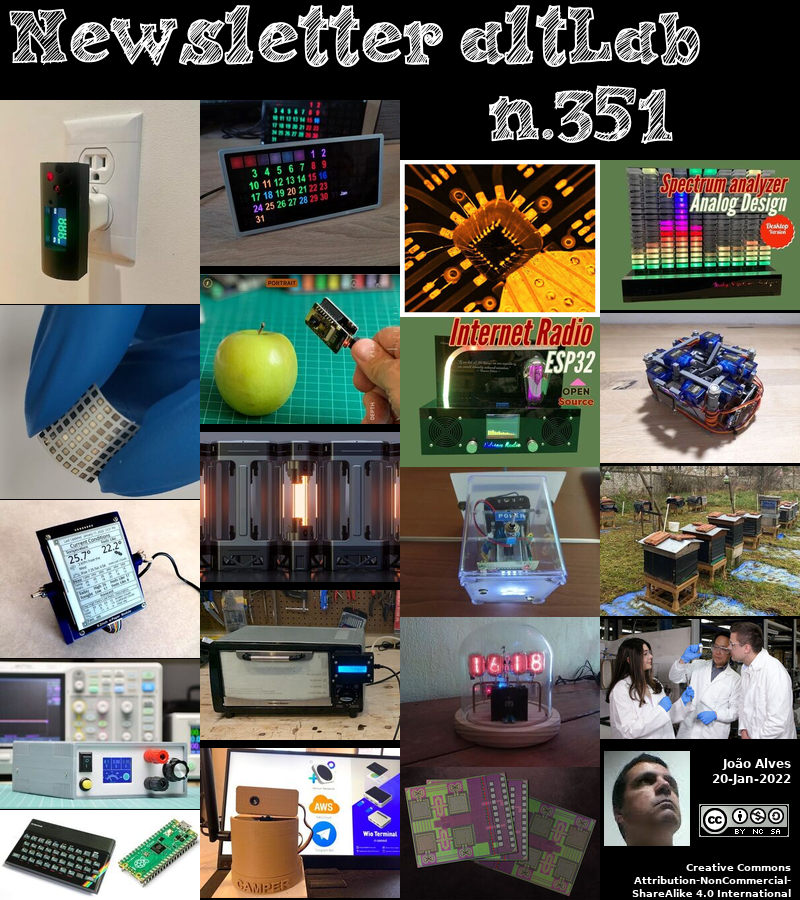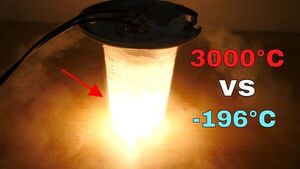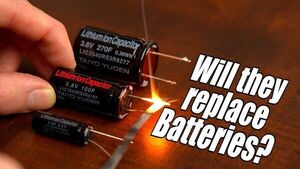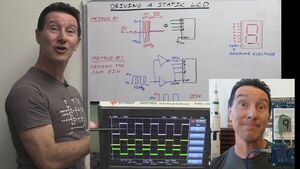2022-01-20 - Nº 351
Editorial
Esta é a Newsletter Nº 351 que se apresenta com o mesmo formato que as anteriores. Se gostar da Newsletter partilhe-a!
Todas as Newsletters encontram-se indexadas no link.
Esta Newsletter tem os seguintes tópicos:
Faz hoje anos que nascia, em 1775, o físico e matemático francês André-Marie Ampère. Ele foi um dos fundadores da ciência do electromagnetismo clássico, a que se referiu como "electrodinâmica". É também o inventor de numerosas aplicações, tais como o solenóide (termo por ele cunhado) e o telégrafo eléctrico. Como autodidacta, Ampère foi membro da Academia Francesa de Ciências e professor na Politécnica de École e no Collège de France. A unidade SI de medição de corrente eléctrica, o ampere, tem o seu nome. O seu nome é também um dos 72 nomes inscritos na Torre Eiffel.
Faz também hoje anos que nascia, em 1899,o engenheiro japonês Kenjiro Takayanagi. Ele foi pioneiro no desenvolvimento da televisão. Apesar de não ter obtido muito reconhecimento no Ocidente, construiu o primeiro receptor de televisão totalmente electrónico do mundo, e é referido como "o pai da televisão". Em 1925, Takayanagi iniciou a investigação na televisão após ter lido sobre a nova tecnologia numa revista francesa. Desenvolveu um sistema semelhante ao de John Logie Baird, utilizando um disco Nipkow para digitalizar o sujeito e gerar sinais eléctricos. Mas ao contrário de Baird, Takayanagi deu o importante passo de utilizar um tubo de raios catódicos para exibir o sinal recebido, desenvolvendo assim o primeiro aparelho de televisão "totalmente-electrónico".
Faz igualmente hoje anos que nascia, em 1930, o astronauta norte-americano Buzz Aldrin. Ele ficou conhecido por ter estabeleceu um recorde de actividade extra-veicular e foi o segundo homem a pôr os pés na Lua. Como antigo piloto da Força Aérea dos EUA na Coreia, foi um dos terceiros astronautas nomeados pela NASA em Outubro de 1963. Em 11 de Novembro de 1966, foi lançado na Gemini 12 com o piloto de comando James Lovell num voo de 4 dias, durante o qual Aldrin estabeleceu um novo recorde de actividade extra-veicular (5½ horas) fora da nave espacial. Aldrin foi o piloto do módulo lunar da Apollo 11, lançado a 16 de Julho de 1969. Esta foi a primeira missão de aterragem lunar tripulada, e Aldrin foi o segundo homem a pôr os pés na Lua, (seguindo Neil Armstrong) a 20 de Julho de 1969, e passou 2 horas e 15 minutos na superfície lunar.
Por fim, faz hoje anos que nascia, em 1931, o físico norte-americano David M. Lee. Ele, com Robert C. Richardson e Douglas D. Osheroff, recebeu em 1996 o Prémio Nobel da Física de 1996 pela sua descoberta conjunta em 1972 de superfluidade no raro isótopo hélio-3. Trabalhando no laboratório de baixa temperatura da Universidade de Cornell, construíram os seus próprios aparelhos para reduzir a temperatura para cerca de 0,002K. Este era substancialmente inferior a cerca de 2K, no qual o hélio-4 do isótopo comum se torna um superfluido, como observado por Pjotr Kapitsa no final da década de 1930. Mas He-3 teve de ser reduzido em temperatura para quase zero absoluto antes de se tornar superfluido, e capaz de fluir sem resistência, mesmo para escalar as paredes dos recipientes e fluir para o exterior. Os átomos tinham, até esse ponto, movido com velocidades e direcções aleatórias. Mas como superfluidos, os átomos movimentam-se então de forma coordenada.
Na Newsletter desta semana apresentamos diversas noticias, artigos científicos, projetos de maker e alguns vídeos interessantes.
 João Alves ([email protected])
João Alves ([email protected])
O conteúdo da Newsletter encontra-se sob a licença  Creative Commons Attribution-NonCommercial-ShareAlike 4.0 International License.
Creative Commons Attribution-NonCommercial-ShareAlike 4.0 International License.
Novidades da Semana
Outras Notícias

Van, Go: Pony.ai Unveils Next-Gen Robotaxi Fleet Built on NVIDIA DRIVE Orin
"High-performance, energy-efficient AI compute platform to be integrated into fleet of Toyota Sienna level 4 autonomous vehicles. Robotaxis are on their way to delivering safer transportation, driving across various landscapes and through starry nights. This week, Silicon Valley-based self-driving startup Pony.ai announced its next-generation autonomous computing platform, built on NVIDIA DRIVE Orin for high-performance and scalable compute. The centralized system will serve as the brain for a robotaxi fleet of Toyota Sienna multipurpose vehicles (MPVs), marking a major leap forward for the nearly six-year-old company. The AI compute platform enables multiple configurations for scalable autonomous driving development, all the way to level 4 self-driving vehicles. “By leveraging the world-class NVIDIA DRIVE Orin SoC, we’re demonstrating our design and industrialization capabilities and ability to develop and deliver a powerful mass-production platform at an unprecedented scale,” said James Peng, co-founder and CEO of Pony.ai, which is developing autonomous systems for both robotaxis and trucks." [...]

Toshiba Releases Photorelays Featuring Low Input Power and High Operating Temperature Suitable For Smart Meters
"Toshiba Electronic Devices & Storage Corporation ("Toshiba") has launched two photorelays, “TLP223GA” and “TLP223J,” with an OFF-state output terminal voltage rating of 400V and 600V, respectively. They both feature low input power, improved switching characteristics, and are housed in a DIP4 package. Shipments start today. The new products come with a high luminous efficiency LED developed by Toshiba and have a maximum trigger LED current of 2mA. This is about 33% lower than current products[1] and allows low input power. Faster operation is secured by lower switching characteristics (turn-on time, turn-off time): 50% for TLP223GA and 75% for TLP223J." [...]

TI buffer amplifier increases signal bandwidth tenfold in data-acquisition systems
"Test and measurement engineers can save months of design time by eliminating the need for custom ASICs and simplifying front-end designs Texas Instruments (TI) (Nasdaq: TXN) today introduced the industry’s widest-bandwidth high-input-impedance (Hi-Z) buffer amplifier, capable of supporting frequency bandwidths as high as 3 GHz. The wider bandwidth and high slew rates of the BUF802 enable higher signal throughput and minimal input settling time. Designers can leverage this faster throughput to measure higher-frequency signals more accurately in test and measurement applications including oscilloscopes, active probes and high-frequency data-acquisition systems. For more information, see www.ti.com/BUF802-pr. The bandwidth achieved by the BUF802 was previously only possible by using application-specific integrated circuits (ASICs) that can increase system design time, complexity and cost. By eliminating ASICs, designers who use TI’s buffer can get to market faster while achieving a wide dynamic range at a fraction of the cost." [...]

STMicroelectronics Brings Ease and Flexibility to USB Power Delivery with Digitally Programmable Synchronous Buck Converter
"Featuring a synchronous topology for optimum efficiency, the STMicroelectronics STPD01 DC/DC buck converter is digitally programmable for USB Power Delivery (PD) applications up to 60W. With a wide input-voltage range of 6V to 26.4V, the STPD01 offers flexibility to address applications such as AC multiport adapters, USB hubs, PC monitors, and smart televisions. The output voltage, set via I2C, can be adjusted from 3V to 20V in 20mV minimum steps to meet PD specifications. The device incorporates cable-drop compensation with an internal voltage-feedback resistor divider, to ensure the load receives the correct voltage unaffected by losses in copper tracks and the attached output cable. The STPD01 includes protection against over-voltage, over-current, and over-temperature. Additional built-in features include embedded discharge circuitry, soft-start, under-voltage lockout, and a programmable watchdog timer that help ensure a robust and safe system." [...]

Panasonic Develops MEGTRON 8 Multi-Layer Circuit Board Materials Featuring Low Transmission Loss for High-Speed Communication Networking Equipment
"Panasonic Corporation announced today that its Industry Company has developed MEGTRON 8[1] Multi-Layer Circuit Board Materials Featuring Low Transmission Loss [2], designed for high-speed communication networking equipment such as routers and switches. The worldwide deployment of the fifth-generation mobile communication system (5G) is fostering the trend of continuous social change toward the Internet of Everything (IoE) where all things will be connected through the Internet. The number of connected terminals and the volume of communication data is expected to increase significantly as IoE technology continues to evolve. In accordance with this trend, solutions for high-speed signal processing and increased power consumption have become major technical challenges. High-speed communication networking equipment, the backbone of IoE technology, will now need to meet 800 GbE[3] (112 Gbps[4], PAM4[5]) targets, which are twice as fast as the current 400 GbE standards. As the electricity flowing through the conductors in printed circuit boards increases in speed and frequency, the transmission loss grows commensurately." [...]
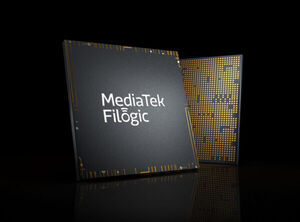
MediaTek Shows The World’s First Live Demos of Wi-Fi 7 Technology to Customers and Industry Leaders
"MediaTek leads in pervasive wireless connectivity with advanced Filogic Wi-Fi 7 technology. MediaTek today announced the world’s first live demo of Wi-Fi 7 technology, highlighting the capabilities of its forthcoming Wi-Fi 7 Filogic connectivity portfolio. MediaTek is currently showcasing two Wi-Fi 7 demos to key customers and industry collaborators to demonstrate the technology’s super-fast speeds and low latency transmission. “The rollout of Wi-Fi 7 will mark the first time that Wi-Fi can be a true wireline/Ethernet replacement for super high-bandwidth applications,” said Alan Hsu, corporate vice president and general manager of the Intelligent Connectivity business at MediaTek. “MediaTek’s Wi-Fi 7 technology will be the backbone of home, office and industrial networks and provide seamless connectivity for everything from multi-player AR/VR applications to cloud gaming and 4K calls to 8K streaming and beyond.” MediaTek’s demo shows how its Wi-Fi 7 Filogic technology can achieve the maximum speed defined by IEEE 802.11be and demonstrates its multi-link operation (MLO) technology. MLO technology aggregates multiple channels on different frequencies bands at the same time to highlight how network traffic can still flow seamlessly even if there is interference or congestion on the bands." [...]
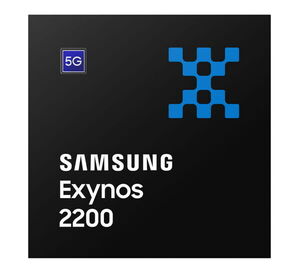
Samsung Introduces Game Changing Exynos 2200 Processor With Xclipse GPU Powered By AMD RDNA 2 Architecture
"The new premium mobile processor comes with hardware-accelerated ray tracing and state of the art Arm-based processing technology Samsung Electronics, a world leader in advanced semiconductor technology, today announced its new premium mobile processor, the Exynos 2200. The Exynos 2200 is a freshly designed mobile processor with a powerful AMD RDNA 2 architecture based Samsung Xclipse graphics processing unit (GPU). With the most cutting-edge Arm®-based CPU cores available in the market today and an upgraded neural processing unit (NPU), the Exynos 2200 will enable the ultimate mobile phone gaming experience, as well as enhancing the overall experience in social media apps and photography. “Built on the most advanced 4-nanometer (nm) EUV (extreme ultraviolet lithography) process, and combined with cutting-edge mobile, GPU and NPU technology, Samsung has crafted the Exynos 2200 to provide the finest experience for smartphone users. With the Xclipse, our new mobile GPU built with RDNA 2 graphics technology from the industry leader AMD, the Exynos 2200 will redefine mobile gaming experience, aided by enhanced graphics and AI performance,” said Yongin Park, President of System LSI Business at Samsung Electronics. “As well as bringing the best mobile experience to the users, Samsung will continue its efforts to lead the journey in logic chip innovation.” The Industry’s First Hardware-Accelerated Ray Tracing on Mobile for the Ultimate Gaming Experience The Xclipse GPU is a one-of-a-kind hybrid graphic processor that is positioned between the console and the mobile graphic processor." [...]

Toshiba Releases High Voltage 1500V Automotive Photorelay
"New device is suited for high voltage automotive batteries. Toshiba Electronic Devices & Storage Corporation ("Toshiba") has launched “TLX9160T,” a normally open (NO) 1-Form-A photorelay suited for high voltage automotive batteries. Housed in an SO16L-T package, the new device is Toshiba’s first to feature a high output withstand voltage of 1500V (min). Volume shipments start today. Incorporation of high voltage MOSFETs in the new device achieves an output withstand voltage of 1500V (min). An SO16L-T package made of a resin in the IEC 60664-1 international standard material group I, which has CTI exceeding 600 and four fewer pins (pins from 11 to 14 are removed from existing SO16L package), realizes creepage of 5mm or more at the device's detector." [...]

ZEVA Successfully Completes Historic First Test Flight
"The zero-emissions electric vertical takeoff and landing (eVTOL) aircraft reaches critical milestone, flying untethered in its first series of taxiing tests ZEVA, a pioneer in zero-emission electric vertical takeoff and landing (eVTOL) aircraft transportation, successfully achieved its first untethered, powered, controlled flight test for its full-scale ZEVA ZERO flying wing airframe utilizing its eight zero-emission electric motor-driven propellers. The major milestone for the Tacoma-based startup was captured in this new video in rural Pierce County, Washington on Sunday, January 9th, 2022 as part of its rigorous test program to achieve FAA airworthiness certification. The uncrewed ZEVA demonstration aircraft completed four flights, totaling more than four minutes of controlled hovering, simulated taxiing maneuvers at slow speeds, and limited vertical climb maneuvers. Its compact airframe is designed for a single pilot and is small enough to fit in a standard automobile parking space. The vehicle is projected to cruise at speeds of up to 160mph with a range of up to 50 miles, optimizing point-to-point travel. “This is a huge inflection point for ZEVA as we join an exclusive set of proven flying eVTOL platforms, and a testament to the relentless hard work and ingenuity of our entire team over the past two and half years,” said Stephen Tibbitts, CEO and Chairman of ZEVA." [...]

Raspberry Pi Direct: buy RP2040 in bulk from just $0.70
"Almost exactly a year ago, we launched Raspberry Pi Pico, the first product powered by our own microcontroller, RP2040. Since then, we’ve sold nearly 1.5 million Picos, and thousands of you have used RP2040 in your own electronic projects and products. Since June, RP2040 has been available through our worldwide network of Approved Resellers, for a single-unit price of $1. This remains the best way to get your hands on the chip for prototyping, and for small- to medium-scale production. But as RP2040 products begin to ramp to scale, and the global semiconductor shortage has transmuted most other microcontrollers into unobtainium, we’ve started to see people asking to buy tens of thousands of chips at a time. To allow us to serve these customers better, today we’re launching Raspberry Pi Direct." [...]

The Moon’s farside has sticky soil, Yutu-2 finds
"The dirt tends to get stuck to the rover’s wheels in clods, but hasn’t hindered the rover yet. The farside of the Moon is a far different place from the nearside. It has a more rugged surface, chock-full of craters. It’s nearly devoid of the smooth, solidified-lava oceans that dot the side that faces us. And it has a different composition, with fewer radioactive elements. Now, you can add “stickier soil” to that list." [...]
Ciência e Tecnologia

Controlling complex systems with artificial intelligence
"Researchers at ETH Zurich and the Frankfurt School have developed an artificial neural network that can solve challenging control problems. The self-learning system can be used for the optimization of supply chains and production processes as well as for smart grids or traffic control systems. Power cuts, financial network failures and supply chain disruptions are just some of the many of problems typically encountered in complex systems that are very difficult or even impossible to control using existing methods. Control systems based on artificial intelligence (AI) can help to optimise complex processes – and can also be used to develop new business models. Together with Professor Lucas Böttcher from the Frankfurt School of Finance and Management, ETH researchers Nino Antulov-Fantulin and Thomas Asikis - both from the Chair of Computational Social Science - have developed a versatile AI-based control system called AI Pontryagin which is designed to steer complex systems and networks towards desired target states. Using a combination of numerical and analytical methods, the researchers demonstrate how AI Pontryagin automatically learns to control systems in near-optimal ways even when the AI has not previously been informed of the ideal solution." [...]

Crystallography for the Misfit Crystals
"Advanced algorithms plus an exceptional X-ray laser can reveal the structures of not-so-neat-and-tidy materials unattainable by other techniques. Francis Crick, who famously co-discovered the shape of DNA, once said: “If you want to understand function, study structure.” Many decades later, this remains a tenet of biology, chemistry, and materials science. A key breakthrough in the quest for DNA’s structure came from X-ray crystallography, a technique that maps the density of electrons in a molecule based on how beams of X-ray radiation diffract through the spaces between atoms in the sample. The diffraction patterns generated by crystallography can then be used to deduce the overall molecular structure. Thanks to a steady stream of advances over the decades, X-ray crystallography is now exponentially more powerful than it was in Crick’s time, and can even reveal the placement of individual atoms. Yet the process is not easy." [...]
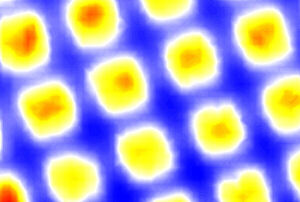
Atomic Armor for accelerators enables discoveries
"Advancement in single-atom layer graphene coatings improves accelerator electron source lifespans. Protective coatings are common for many things in daily life that see a lot of use: we coat wood floors with finish; apply Teflon to the paint on cars; even use diamond coatings on medical devices. Protective coatings are also essential in many demanding research and industrial applications. Now, researchers at Los Alamos National Laboratory have developed and tested an atomically thin graphene coating for next-generation, electron-beam accelerator equipment – perhaps the most challenging technical application of the technology, the success of which bears out the potential for “Atomic Armor” in a range of applications. “Accelerators are important tools for addressing some of the grand challenges faced by humanity,” said Hisato Yamaguchi, member of the Sigma-2 group at the Laboratory. “Those challenges include the quest for sustainable energy, continued scaling of computational power, detection and mitigation of pathogens, and study of the structure and dynamics of the building blocks of life." [...]

Decrypting the interdependence of cryptocurrencies
"The statistics of extreme events reveals that cryptocurrency prices tend to fall in tandem but rise more independently. As cryptocurrency becomes more mainstream, understanding its behavior is a new take on weighing up risk. KAUST’s analysis of price movements for the top five cryptocurrencies has used statistics designed to account for rare events to provide new insights into their market behavior. The research will help investors assess levels of diversification, and the risk of simultaneous price falls and gains. Understanding risk is critical to investing. One of the ways investors manage their risk exposure and mitigate against potential losses is to diversify their holdings across assets that are not correlated." [...]

Encapsulation as a method for preventing degradation in Li-air batteries
"Discovery allows scientists to study crucial intermediate in battery development. Lithium-air batteries were thought promising in the 1970s as a potential power source for electric vehicles, offering energy densities that rival gasoline and significantly surpass conventional lithium-ion batteries. However, scientists over the last few decades have been unable to overcome challenges to practical application of this technology, including reversible charging and low cyclability that results in battery degradation over few uses. A research team from MIT, Harvard University, and Cornell University has found a way to isolate and study one enigmatic molecule that may be responsible for the breakdown of key components in Li-air batteries — lithium superoxide. “The key to trapping lithium superoxide is by using a confining shell of quinone—a molecule used as an energy carrier in biology,” says Matthew Nava PhD '17, lead author of a paper on the work, published recently in PNAS. Nava, who is now a postdoc at Harvard University working in the laboratory of Patterson Rockwood Professor of Energy Daniel G. Nocera, contributed to the work as a researcher in the lab of Henry Dreyfus Professor of Chemistry Christopher Cummins, who is a senior author of the study; along with Shiyu Zhang from MIT; Katharine Pastore and Kyle Lancaster from Cornell University; and Xiaowen Feng and Daniel Nocera of Harvard." [...]
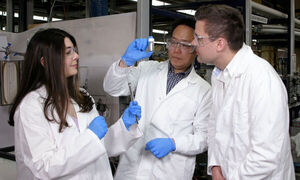
Decarbonisation tech instantly converts CO2 to solid carbon
"Researchers have developed a smart and super-efficient new way of capturing carbon dioxide and converting it to solid carbon, to help advance the decarbonisation of heavy industries. The carbon dioxide utilisation technology from RMIT researchers is designed to be smoothly integrated into existing industrial processes. Decarbonisation is an immense technical challenge for heavy industries like cement and steel, which are not only energy-intensive but also directly emit CO2 as part of the production process. The new technology offers a pathway for instantly converting carbon dioxide as it is produced and locking it permanently in a solid state, keeping CO2 out of the atmosphere. The research is published in the journal Energy & Environmental Science. Co-lead researcher Associate Professor Torben Daeneke said the work built on an earlier experimental approach that used liquid metals as a catalyst." [...]

New Study Shows Novel Crystal Structure for Hydrogen Under High Pressure
"Researchers identify a potential crystal phase for hydrogen solidified at extreme pressures using data science and supercomputer simulations Being the first element to form, hydrogen holds clues about the distribution of matter in our universe. Normally a gas, hydrogen exists as a solid under ultra-high-pressure conditions commonly found in the core of giant gaseous planets. However, the structures of solid hydrogen have remained elusive owing to difficulties in replicating such conditions experimentally. Now, a new study sheds light on this aspect using simulations and data science methods. Elements in the periodic table can take up multiple forms. Carbon, for example, exists as diamond or graphite depending on the environmental conditions at the time of formation." [...]
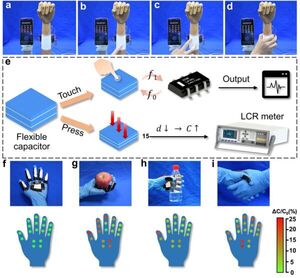
USTC Finds a New Way Out for Flexible Electronics
"Flexible electronics generally refer to the electronic devices built on conformable or stretchable substrates. On account of their rapid development in the information era, flexible electronics were thought very highly of and have been applied into various fields including electronic skin, human-computer interaction, and implantable medical systems already. As the Internet of Things has stepped into a new stage, multifunctional and highly integrated flexible electronic systems are urgently required to meet more complex application scenarios. Under the challenge of increasingly grim environmental and energy problems, a simple, fast, and green flexible electronics preparation method was put forward by the research team led by Prof. ZHAO Gang from the University of Science and Technology of China (USTC) to deal with the key constraints of materials and fabrication techniques. This work was published in ACS Nano. In this work, researchers prepared the thermoplastic polyurethane (TPU) membrane by electrospinning, which was used as the substrate, and then the liquid metal (LM) could be printed into various patterns on the substrate through premade templates." [...]

The Quantum Field Theory on Which the Everyday World Supervenes
"The laws of physics underlying everyday life are, at one level of description, completely known, and can be summarized in a single elegant — if quite complex — equation. That’s the claim physicist Sean Carroll, an SFI Fractal Faculty member and External Professor, makes in a recent paper. Objects in our everyday world — people, planets, puppies — are made up of atoms and molecules. Atoms and molecules, in turn, are made of elementary particles, interacting via a set of fundamental forces. And these particles and forces are accurately — and completely, Carroll argues — described by the principles of quantum field theory, in a model known as the “Core Theory.” All the things we humans experience in our day-to-day lives — the warmth of sunlight, the gravitational pull of the Earth, the kinetic energy required to move our bodies through space — are beholden to and can be explained by Core Theory. Don’t worry that physicists will soon be out of their jobs, though." [...]
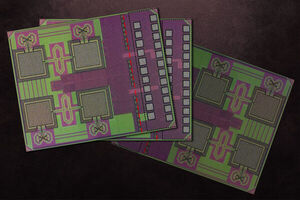
Reasserting U.S. leadership in microelectronics
"MIT researchers lay out a strategy for how universities can help the U.S. regain its place as a semiconductor superpower. The global semiconductor shortage has grabbed headlines and caused a cascade of production bottlenecks that have driven up prices on all sorts of consumer goods, from refrigerators to SUVs. The chip shortage has thrown into sharp relief the critical role semiconductors play in many aspects of everyday life. But years before the pandemic-induced shortage took hold, the United States was already facing a growing chip crisis. Its longstanding dominance in microelectronics innovation and manufacturing has been eroding over the past several decades in the face of stepped-up international competition. Now, reasserting U.S. leadership in microelectronics has become a priority for both industry and government, not just for economic reasons but also as a matter of national security." [...]

When graphene speaks, scientists can now listen
"Brothers in Rice lab find audio from graphene production contains valuable data It may be true that seeing is believing, but sometimes hearing can be better. Case in point: Two brothers in a Rice University laboratory heard something unusual while making graphene. Ultimately, they determined the sound itself could give them valuable data about the product. The brothers, John Li, a Rice alumnus now studying at Stanford University, and Victor Li, then a high school student in New York and now a freshman at the Massachusetts Institute of Technology, are co-lead authors of a paper that describes the real-time analysis of laser-induced graphene (LIG) production through sound. The brothers were working in the lab of Rice chemist James Tour when they came up with their hypothesis and presented it at a group meeting. “Professor Tour said, ‘It is interesting,’ and told us to pursue it as a potential project,” John Li recalled." [...]
Quantum computing in silicon hits 99 per cent accuracy
"UNSW Sydney-led research paves the way for large silicon-based quantum processors for real-world manufacturing and application. Australian researchers have proven that near error-free quantum computing is possible, paving the way to build silicon-based quantum devices compatible with current semiconductor manufacturing technology. “Today’s publication shows our operations were 99 per cent error-free,” says Professor Andrea Morello of UNSW, who led the work with partners in the US, Japan, Egypt, and at UTS and the University of Melbourne. “When the errors are so rare, it becomes possible to detect them and correct them when they occur. This shows that it is possible to build quantum computers that have enough scale, and enough power, to handle meaningful computation.” The team’s goal is building what’s called a ‘universal quantum computer’ that won’t be specific to any one application. “This piece of research is an important milestone on the journey that will get us there,” Prof. Morello says." [...]
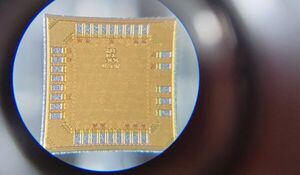
Less wattage, more brain power
"Since they came into use by physicians and researchers, Brain-Computer Interfaces (BCIs) or Brain-Machine Interfaces (BMIs) have provided ways to treat neurological disorders and shed light on how the brain functions. As beneficial as they’ve been, BCIs have potential to go far beyond the technology's current capabilities. In a collaboration between the Yale School of Engineering & Applied Science (SEAS) and Yale School of Medicine, a team of researchers are looking to break through these limitations. “The goal is to build a class of ultra-low-power devices that are safe for chronic implantation in humans,” said Abhishek Bhattacharjee, associate professor of computer science. “Chronic implantation opens the door to a number of clinical uses, ranging from implants to treat epilepsy and movement disorders to designing assistive devices for patients with paralysis, as well as many research uses.” Chronic implantation is the practice of placing a device in the brain of patients, who then go about their daily lives, albeit with regular check-ins with their doctors. At SEAS, Bhattacharjee has been working on this with Rajit Manohar, the John C. Malone Professor of Electrical Engineering and Computer Science, and Anurag Khandelwal, assistant professor of computer science." [...]

Controlling how “odd couple” surfaces and liquids interact
"Spread out or bead up? A new process enables control over liquid-solid interfaces even with the most unlikely pairs of materials. The wettability of a surface — whether drops of water or another liquid bead up or spread out when they come into contact with it — is a crucial factor in a wide variety of commercial and industrial applications, such as how efficiently boilers and condensers work in power plants or how heat pipes funnel heat away in industrial processes. This characteristic has long been seen as a fixed property of a given pair of liquid and solid materials, but now MIT researchers have developed a way of making even the most unlikely pairings of materials take on a desired level of wettability. The new process is described this week in the journal Proceedings of the National Academy of Sciences (PNAS), in a paper by MIT postdocs Kyle Wilke, Zhengmao Lu, and Youngsup Song and professor of mechanical engineering Evelyn Wang. Wettability is usually closely linked to the surface tension properties of a liquid — the higher the surface tension, the more likely the liquid is to form beads on a surface rather than spreading out to wet the surface." [...]

Researchers Use Electrically Responsive Fluid to Make Eye-Like Adaptive Lens
"Simple and lightweight lens could be useful for mobile phone cameras, endoscopes and more Researchers have developed an adaptive liquid lens based on a new electrically responsive fluid called dibutyl adipate (DBA) that changes focal length when a voltage is applied. The lens is lightweight, compact and simple to fabricate, which makes it ideal for mobile phone cameras, endoscopes, eyeglasses and machine vision applications. “The human eye can arbitrarily focus on objects at different distances at incredibly fast speeds,” said research team leader Miao Xu from Hefei University of Technology in China. “Inspired by this functionality, we developed an eye-like adaptive liquid lens that can be used to diverge or converge light by changing the shape of the DBA liquid.” In the Optica Publishing Group journal Optics Letters, the researchers describe their new DBA-based adaptive liquid lens, which weighs just a few grams, and show that it exhibits high optical performance with good stability. DBA’s electronegative molecular structure allows an applied voltage to be used to rapidly change the lens’ shape to modify its focal length. DBA is also transparent, non-volatile and inexpensive, making it ideal for use in adaptive liquid lenses." [...]

It all comes down to the first electron
"All living organisms that respire have to get rid of electrons. In oxygen-free environments, microorganisms deploy special molecules which act as extracellular electron shuttles to transfer the electrons from cells to minerals. A group of researchers has now discovered what determines the electron transfer efficiency of these "cabs". Every living thing requires energy. This is also true of microorganisms. This energy is frequently generated in the cells by respiration, that is by the combustion of organic compounds, in other words: food." [...]
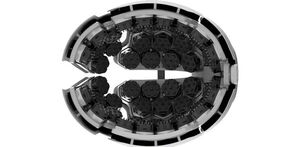
Kernel Flow: a wearable device for noninvasive optical brain imaging
"A new wearable helmet-shaped device monitors brain activity Recent advances in brain imaging techniques facilitate accurate, high-resolution observations of the brain and its functions. For example, functional near-infrared spectroscopy (fNIRS) is a widely used noninvasive imaging technique that employs near-infrared light (wavelength >700 nm) to determine the relative concentration of hemoglobin in the brain, via differences in the light absorption patterns of hemoglobin. Most noninvasive brain scanning systems use continuous-wave fNIRS, where the tissue is irradiated by a constant stream of photons. However, these systems cannot differentiate between scattered and absorbed photons. A recent advancement to this technique is time-domain (TD)-fNIRS, which uses picosecond pulses of light and fast detectors to estimate photon scattering and absorption in tissues. However, such systems are expensive and complex and have a large form factor, limiting their widespread adoption." [...]

Scientists overcome a hurdle on the path to renewable-energy storage
"EPFL scientists have observed how catalysts behave at the particle level during water electrolysis. Catalysts play a crucial role in this reaction, in which water splits into hydrogen and oxygen. By shedding light on the underlying mechanism of the functional role of catalysts during the reaction, the scientists have made an important discovery for the design of renewable-energy storage systems. If renewable energies are one day to replace fossil fuels, engineers need to find a way to store it reliably and on a large scale. One method that numerous researchers are currently studying involves storing the energy in gaseous form inside electrolytic cells. Electrolytic cells work by using electricity to trigger an electrolysis reaction that splits water molecules into hydrogen and oxygen." [...]
Semiconductor spin qubits gain further credibility as leading platform for quantum computing
"Researchers at QuTech—a collaboration between the Delft University of Technology and TNO—have taken an important step for semiconductor spin qubits by surpassing the 99% barrier for two-qubit gate fidelity. They report on their findings in Nature on 20 January 2022 and are featured on the issue’s cover. Two independent works from groups at UNSW Sydney and at RIKEN report similar results in the same issue of Nature. Advantages Semiconductor spin qubits are well positioned as the building block for a future quantum computer. Among all the candidate platforms, electron spins in semiconductor quantum dots have advantages for their long coherence times, small footprint, the potential for scaling up, and the compatibility with advanced semiconductor manufacturing technology. A major challenge however is to implement operations with sufficient accuracy to arrive at a reliable outcome." [...]

Century-old electrochemistry law gets update
"The Gouy-Chapman theory describes what happens near an electrode when it is in contact with a salt solution, but this description does not match reality. Researcher Kasinath Ojha, assistant professor Katharina Doblhoff-Dier and professor Marc Koper present a new version. ‘The next generation of textbooks on electrochemistry is going to look different.’ When you look inside a fuel cell, one of the things you will see is an electrode, often made of platinum. This piece of metal is in contact with a salt solution, which contains positively and negatively charged particles called ions. If you were to zoom in on the interface between the electrode and the salt solution, you would perceive all kinds of interactions. At the surface of the electrode, a shortage or abundance of electrons exists." [...]
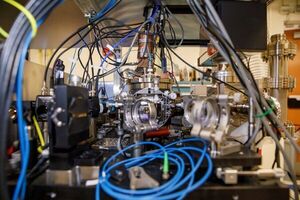
Measuring a quantum computer’s power now faster and more accurate
"Scientists at Sandia invent new yardstick for benchmarking performance What does a quantum computer have in common with a top draft pick in sports? Both have attracted lots of attention from talent scouts. Quantum computers, experimental machines that can perform some tasks faster than supercomputers, are constantly evaluated, much like young athletes, for their potential to someday become game-changing technology. Scientist-scouts now have their first tool Scientists achieve key elements for fault-tolerant quantum computation in silicon spin qubitsto rank a prospective technology’s ability to run realistic tasks, revealing its true potential and limitations. A new kind of benchmark test, designed at Sandia, predicts how likely it is that a quantum processor will run a specific program without errors. The so-called mirror-circuit method, published recently in Nature Physics, is faster and more accurate than conventional tests, helping scientists develop the technologies that are most likely to lead to the world’s first practical quantum computer, which could greatly accelerate research for medicine, chemistry, physics, agriculture and national security." [...]
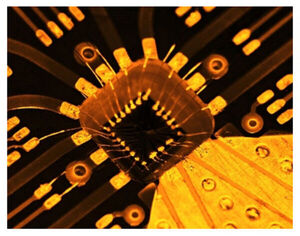
Scientists achieve key elements for fault-tolerant quantum computation in silicon spin qubits
"Researchers from RIKEN and QuTech—a collaboration between TU Delft and TNO— have achieved a key milestone toward the development of a fault-tolerant quantum computer. They were able to demonstrate a two-qubit gate fidelity of 99.5 percent—higher than the 99 percent considered to be the threshold for building fault-tolerant computers—using electron spin qubits in silicon, which are promising for large-scale quantum computers as the nanofabrication technology for building them already exists. The world is currently in a race to develop large-scale quantum computers that could vastly outperform classical computers in certain areas. However, these efforts have been hindered by a number of factors, including in particular the problem of decoherence, or noise generated in the qubits. This problem becomes more serious with the number of qubits, hampering scaling up. In order to achieve a large-scale computer that could be used for useful applications, it is believed that a two-qubit gate fidelity of at least 99 percent to implement the surface code for error correction is required." [...]
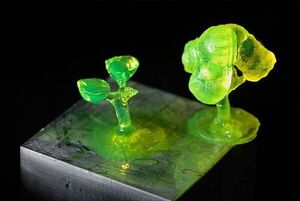
Creating Value From Waste
"Robert O’Dea is a chemical engineering doctoral student working in the lab of Professor Thomas Epps and co-author on a new paper which looks at methods of repurposing lignin, the hardest-to-recycle part of trees, grasses and other biomass. UD researchers report low-pressure method to convert industrially processed biomass into plastics, chemicals It’s no secret that we need more sustainable materials if we hope to help the planet. Bio-derived materials are one potential option, but they must be economical if anyone is going to use them. For instance, a better bio-based milk jug would be great. However, if the milk sells for $20 per gallon because the cost of the jug increases from $1 to $17, no one will buy it. Led by Professor Thomas H. Epps, III, a team of University of Delaware researchers and collaborators from CanmetENERGY are keeping just this type of economics in mind as they look for ways to upcycle biomass into new products." [...]
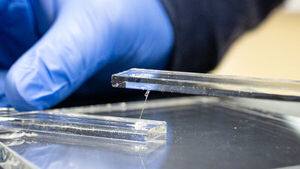
Polymer upcycling of common plastic adds toughness, recyclability to structural adhesives
"Researchers at the Department of Energy’s Oak Ridge National Laboratory used polymer chemistry to transform a common household plastic into a reusable adhesive with a rare combination of strength and ductility, making it one of the toughest materials ever reported. The study, published in Science Advances, fundamentally advances pathways to design a new class of tough adhesives with desirable features merged into a single material. The technology adapts to bear heavy loads, tolerate extreme stress and heat, and reversibly bond to various surfaces including glass, aluminum and steel. “Strong, tough adhesives are difficult to design because they need to incorporate hard and soft features that are not typically compatible,” said ORNL scientist and corresponding author Tomonori Saito. Structural adhesives such as epoxy are largely designed for load-bearing strength but lack toughness, a property that helps materials dissipate stress when pulled or stretched to prevent sudden failure. “The challenge has been to add the toughness you get in flexible materials without sacrificing strength." [...]
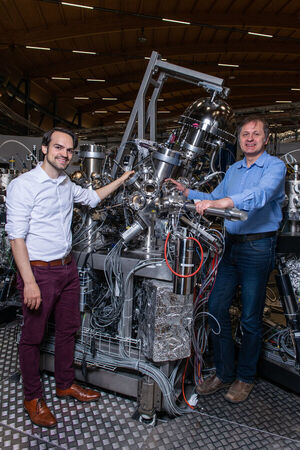
Towards compact quantum computers, thanks to topology
"Researchers at PSI have compared the electron distribution below the oxide layer of two semiconductors. The investigation is part of an effort to develop particularly stable quantum bits –and thus, in turn, particularly efficient quantum computers. They have now published their latest research, which is supported in part by Microsoft, in the scientific journal Advanced Quantum Technologies. By now, the future of computing is inconceivable without quantum computers. For the most part, these are still in the research phase. They hold the promise of speeding up certain calculations and simulations by orders of magnitude compared to classical computers." [...]

Camels’ noses inspire a new humidity sensor
"Camels have a renowned ability to survive on little water. They are also adept at finding something to drink in the vast desert, using noses that are exquisite moisture detectors. In a new study in ACS Nano, researchers describe a humidity sensor inspired by the structure and properties of camels’ noses. In experiments, they found this device could reliably detect variations in humidity in settings that included industrial exhaust and the air surrounding human skin. Humans sometimes need to determine the presence of moisture in the air, but people aren’t quite as skilled as camels at sensing water with their noses. Instead, people must use devices to locate water in arid environments, or to identify leaks or analyze exhaust in industrial facilities." [...]

Superabsorption unlocks key to next generation quantum batteries
"Researchers at the University of Adelaide and their overseas partners have taken a key step in making quantum batteries a reality. They have successfully proved the concept of superabsorption, a crucial idea underpinning quantum batteries. “Quantum batteries, which use quantum mechanical principles to enhance their capabilities, require less charging time the bigger they get,” said Dr James Q. Quach, who is a Ramsay Fellow in the School of Physical Sciences and the Institute for Photonics and Advanced Sensing (IPAS), at the University of Adelaide. “It is theoretically possible that the charging power of quantum batteries increases faster than the size of the battery which could allow new ways to speed charging.” To prove the concept of superabsorption, the team – who published their findings in the journal Science Advances –built several wafer-like microcavities of different sizes which contained different numbers of organic molecules. Each was charged using a laser. “The active layer of the microcavity contains organic semiconductor materials that store the energy." [...]

Towards quantum simulation of false vacuum decay
"By shaking an optical lattice potential, researchers in Cambridge have realized a discontinuous phase transition in a strongly correlated quantum gas, opening the door to quantum simulations of false vacuum decay in the early universe. Phase transitions are everywhere, ranging from water boiling to snowflakes melting, and from magnetic transitions in solids to cosmological phase transitions in the early universe. Particularly intriguing are quantum phase transitions that occur at temperatures close to absolute zero and are driven by quantum rather than thermal fluctuations. Researchers in the University of Cambridge studied properties of quantum phases and their transitions using ultracold atoms in an optical lattice potential (formed by a set of standing wave lasers). Typically, the transition from a Mott insulator (MI) to a superfluid (SF), which is governed by the interplay of the atom-atom interactions and the hopping of atoms, is a continuous transition, where the system undergoes a smooth continuous change crossing the phase transition point. However, many phase transitions are discontinuous, such as water freezing to ice, or the transition thought to have triggered the inflation period in the early universe." [...]

Largest ever 3-D map of the universe created
"We’re part of an international team that has helped to create the most detailed 3-D map of the universe ever. The Dark Energy Spectroscopic Instrument (DESI) has capped off the first seven months of its survey run by smashing through all previous records for three-dimensional galaxy surveys. Durham is a key partner of DESI and helped design and build the new telescope instrument. Although it is already producing unprecedented outcomes, DESI is only about ten per cent through its five-year mission. Dark energy Once completed, its phenomenally detailed 3-D map will give scientists a better understanding of dark energy – the mysterious substance that accounts for 70 per cent of the content in the universe and is speeding up its expansion. This will help scientists determine if the universe will expand forever, collapse in on itself in a reverse Big Bang or rip itself apart." [...]
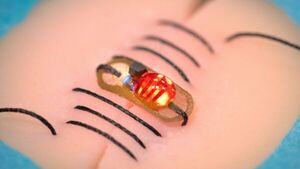
Smart sutures to monitor deep surgical wounds
"Monitoring surgical wounds after an operation is an important step to prevent infection, wound separation and other complications. However, when the surgical site is deep in the body, monitoring is normally limited to clinical observations or costly radiological investigations that often fail to detect complications before they become life-threatening. Hard bioelectronic sensors can be implanted in the body for continuous monitoring, but may not integrate well with sensitive wound tissue. To detect wound complications as soon as they happen, a team of researchers led by Assistant Professor John Ho from the NUS Electrical and Computer Engineering as well as the NUS Institute for Health Innovation & Technology has invented a smart suture that is battery-free and can wirelessly sense and transmit information from deep surgical sites. These smart sutures incorporate a small electronic sensor that can monitor wound integrity, gastric leakage and tissue micromotions, while providing healing outcomes which are equivalent to medical-grade sutures. This research breakthrough was first published in scientific journal Nature Biomedical Engineering on 15 October 2021." [...]
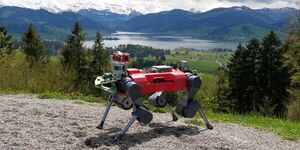
How robots learn to hike
"ETH Zurich researchers led by Marco Hutter developed a new control approach that enables a legged robot, called ANYmal, to move quickly and robustly over difficult terrain. Thanks to machine learning, the robot can combine its visual perception of the environment with its sense of touch for the first time. Steep sections on slippery ground, high steps, scree and forest trails full of roots: the path up the 1,098-metre-high Mount Etzel at the southern end of Lake Zurich is peppered with numerous obstacles. But ANYmal, the quadrupedal robot from the Robotic Systems Lab at ETH Zurich, overcomes the 120 vertical metres effortlessly in a 31-minute hike. That’s 4 minutes faster than the estimated duration for human hikers – and with no falls or missteps. This is made possible by a new control technology, which researchers at ETH Zurich led by robotics professor Marco Hutter recently presented in the journal Science Robotics." [...]
Projetos Maker
Diversos Projetos interessantes.
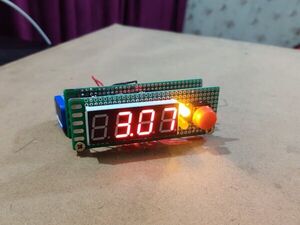
Pomodoro device
"A simple device to make your Pomodoro style of work more fun A few years back while trying to figure out how to work efficiently, I came across a method of utilising the time and not feeling burned up at the end of it. Pomodoro was the name of that technique. You work for 25 min and take a 5 mins break after. Then a few months later I started playing with Arduino and fell in love with its capabilities. This project is marriage of these two things. The provided code can be changed to work for any sequence of events with existing hardware setup." [...]
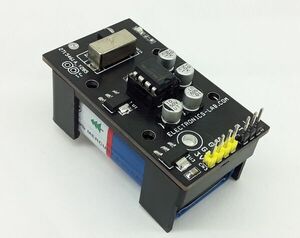
Multiple Output Power Source – Dual 10V (+/-10V), 5V DC, 3.3V DC from 9V Battery
"This is a multiple output power converter module that provides +/-10V (Dual 10V), 5V DC, and 3.3V DC from a 9V PP3 battery. This is a very useful project that has been designed for low-load current applications. Dual +/-10V output from a 9V battery is a key feature of the project. The battery holder can be mounted on the backside of the PCB. An onboard slide switch provides power ON/OFF. Onboard LED indicates the power." [...]
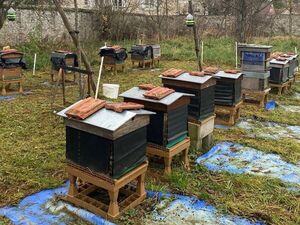
How to monitor a beehive with Arduino Nano 33BLE (bluetooth)
"You have a beehive and you want to optimise your interventions ? Checkout our project where we embed sensors in the beehive. Our team was led to rub shoulders with beekeepers and after few exchanges some issues appeared. Indeed, beekeepers do not always have the time to check their beehives or the weather might nt be suitable (heavy rain, strong wind) for checking. Thus, they asked us if there is a way to remotely monitor their beehives. They gave us the technical specifications we would have to meet and we started to design a solution for them." [...]

AutoStrap - a Self Tightening Strap
"Hello world! The AutoStrap was created to get rid of the hassle of tightening straps that are put on any part of your body. Just like the shoes from Back to the Future, you simply push a button and the strap will tighten until it is tight enough that it won't slip off. This can be used to help those who have trouble putting on arm or leg braces as they do not need to bend down and forcefully tighten the straps. The video at the end of this Instructable shows it at work! This is a pretty straightforward project with little technological knowledge necessary." [...]
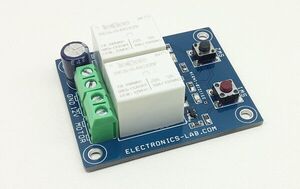
Low-Cost DC Motor Direction Controller with Fast Brake using 2 Relays
"The project presented here is a low-cost easy to use DC brushed motor direction controller with fast-brake, the project was built using two 12V Relays, 2 x BJT transistors, and 2 x tactile switches. The two LEDs are provided to display the motor direction, 2 tactile switch controls the direction of the motor. OPERATION Connect 12V DC power supply to connector CN1, connect 12V DC brushed Motor to CN2. The motor will run in any direction by pressing any of the switches, other switch will rotate the motor in another direction. When the user leaves the switch fast brake apply as both terminals of the motor are short when both relays are in an OFF state. " [...]

LED Lantern With Joule Thief
"This is a small LED lantern to be installed inside the farm storage house. As the size of the storage house is less than 10 square meters, the brightness of the LED lantern is not necessarily high and strong. This lantern shall be hanging under the ceiling of the storage house to shine 2 to 3 meters in radius. As no wall outlet is available inside the storage house, the lantern should be powered with a battery. But 1.5V batteries (AA or AAA size) are the kind of luxury in the rural area where I live, a cheap and affordable solution is necessary for making the LED lantern. Although buying a brand new battery is difficult, still I can get many used batteries from neighbors." [...]

Introducing Serial Studio, a dashboard software for serial port projects
"Did you ever have the need to display data from a microcontroller on a dashboard, and spent more time developing (and fixing) your dashboard software, than actually working on your MCU project? Well, I did, multiple times. Let me put you in context, I participate in several CanSat competition programs through KA'AN SAT, a representative team at my university. A CanSat is “a simulation of a real satellite, integrated within the volume and shape of a soft drink can” (European Space Agency, more info). One of the main tasks in these competitions is to develop software for the ground station. The ground station software (GSS) receives telemetry from the CanSat in real time through a serial device (generally a XBee), displays it and exports it to a CSV/Excel file for post-mission analysis." [...]

Dual 40W Audio Power Amplifier with Mute
"The stereo audio amplifier project shown here is capable of delivering typically 40W per channel continuous average output power into an 8Ω load with less than 0.1% (THD+N). The project is built using an LM4766 chip from Texas Instruments, The performance of the LM4766, utilizing its Self-Peak Instantaneous Temperature (°Ke) (Spike) Protection Circuitry, places it in a class above discrete and hybrid amplifiers by providing an inherently, dynamically protected Safe Operating Area (SOA). Spike Protection means that these parts are safeguarded at the output against overvoltage, undervoltage, overloads, including thermal runaway and instantaneous temperature peaks. Each amplifier within the LM4766 has an independent smooth transition fade-in/out mute that minimizes output pops. The IC’s extremely low noise floor at 2µV and its extremely low THD+N value of 0.06% at the rated power make the LM4766 optimum for high-end stereo TVs or mini-component systems. " [...]

threeboard
"threeboard is a fully-functional open source and open hardware mechanical USB computer keyboard with only three keys. It supports multiple programmable layers, and achieves the same functionality as a full-sized keyboard. Its firmware and hardware are built completely from scratch and are extensively documented. Unlike a traditional keyboard, characters don't show up on the screen after each keypress, because there aren't enough keys. Instead, combinations of the three keys are used to specify key and modifier codes on two built-in 8-bit LED binary indicators. This can then be sent to the host computer as USB keycodes." [...]
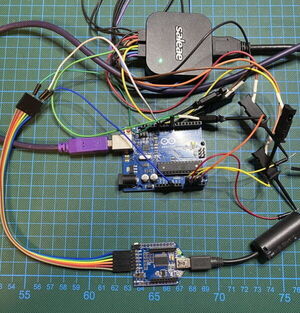
SingleWireSerial - Arduino Library that Supports Single-Wire Half-Duplex Serial Communication
"A new Arduino library has seen the light of day: SingleWireSerial. It supports single-wire, half-duplex serial communication. By using the input capture feature of the AVR MCUs, it is extremely accurate and supports bitrates up to 250 kbps robustly. And contrary to its title, one can even use it in a two-wire setting. Background Earlier this year, I worked on a hardware debugger making use of the debugWIRE protocol. But I couldn’t get it to work reliably." [...]
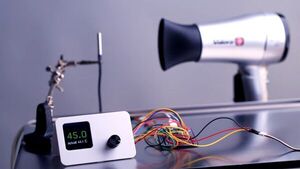
Heat-o-matic
"A proportional integral derivative (PID) controller that will be used to run a home-made precision heater. PID is a fancy way of saying that the code plays a game of 'Warmer', 'Colder' to get something to a particular value (in our example, a particular temperature). The internet is littered with examples of these things, so it is primarily a didactic exercise that will use a few bits of code we've previously developed, and hopefully it will make us a little smarter along the way. (You can use the PID controller to regulate other things, depending on the sensor and device being powered. It just needs to measure something, and to be able to influence that measurement. People have used PID controllers to make robots follow lines, and other things I can't think of right now)" [...]
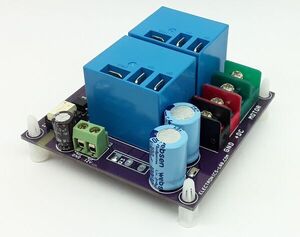
DC Motor Controller using Relay and MOSFET – Arduino Interface
"The project presented here is a low-cost solution to control high power brushed DC motor speed and direction. Traditional DC motor controllers are based on solid-state circuitry known as H-Bridge. Here we have made an H-bridge configuration using high current 2 x relays which can handle high voltage as well as high current. Additional MOSFETs are used to control the speed of motor. These MOSFETs can be removed in case of only direction control required, short the Drain and source pin of MOSFETs. The project requires 3 control input signals, all inputs are optically isolated to prevent noise and high voltage going in to logic circuitry." [...]
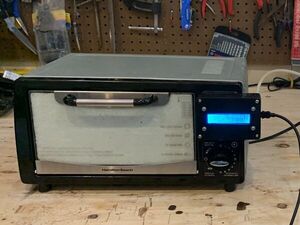
Toaster Oven Conversion to SMD Reflow Oven
"Arduino Nano controls the elements of a Toaster Oven based on temperature readings to reflow tin-lead solder paste on a SMD PCB. I’m getting too old to solder surface mount devices by hand so I decided to convert a toaster oven into a reflow oven. There are tons of examples on the internet but I believe the best one is from Whizzo. I used many of the Whizoo methods for sealing and insulating the oven but I’m on a tight budget and can’t afford their kit. Besides, it’s a lot more fun to figure out my own design and learn along the way. My requirements are not as challenging as Whizoo’s because I only solder one small board at a time and I use standard tin-lead solder." [...]
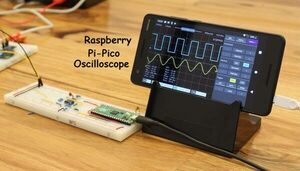
Raspberry Pi Pico 200Khz Digital Oscilloscope
"A Waveform analyzer, Signal generator and logic tester in a small PI PICO. With a dedicated application, Runs on Android. Supplies Things needed for this projects: 1) Smart phone as display unit 2) Raspberry pi Pico 3) 1k, 100k resistors 4) Breadboard, jumper and usb wires 5) PCB and other soldering equipments* optional 6) OTG Jack Features of Oscilloscope: - 200Khz bandwidth - 2-channel supported - 500KS/s sampling rate - Time/div: 5micro Second to 20 Sec - Needs a very few components - Accuracy: +-10% - Onboard 1khz wave for testing - Low power consumption - USB Interface" [...]
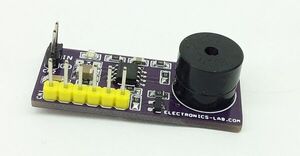
Under Speed Warning Alarm for Magnetic Pickup sensor – Frequency Controlled Switch
"This is an under-speed sensor module that provides an audible warning and signals output when the speed of a machine is below the set point. The module can be used in applications such as Engines, Machines, Sports machines, Fitness Equipment, Speed of the machine or engine can be detected using a magnetic pickup sensor. The project can be used in many applications where an under-speed monitor is important. The project is based on the LM2907 chip which works as a frequency to voltage converter, interfacing of magnetic pickup as shown in the figure below. A typical magnetic pickup for automotive applications will provide a thousand pulses per mile so that at 60 mph the incoming frequency will be ~16.6 Hz. If the reference level on the comparator is set by two equal resistors R2 and R6 then the desired value of C5 and R4 can be determined from the simple relationship: The buzzer is activated when Frequency ≥ (1/(2XR4C5)) From the RC selection chart, we can choose the suitable values for R5 and C5." [...]
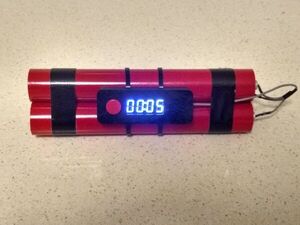
Dynamite Kitchen Timer
"An interesting twist on a kitchen timer. A few weeks ago, I picked up some 20mm PVC pipe that someone had put out for council pickup. On the journey back home, I wondered what I could make with it. This build is what I came up with. " [...]

Desktop Analog Spectrum Analyzer
"This spectrum analyser with 10 channels uses an analog back-end to analyse the incoming signal from line-in or microphone. Acrylic display. The analogue back end of this 10 channel spectrum analyzer uses 10 band pass filters to divide the input signal into 10 frequency bands You can connect your audio signal by using the audio input or you can use the microphone input to connect a small condenser microphone. Although using the microphone will limit the frequency response because of its limitations. The input sensitivity can by adjusted just like brightness and peak hold time. When it does not receive any input signal, after a while, it will go to fire mode in which some leds/display will light up like a fire." [...]

Introducing the ATtiny Device PCB - I2C slave devices
"Ever since I started playing with Arduinos and microcontrollers, I was always fascinated by one very specific chip. The Attiny85! I know, I know! It's not the fastest microcontroller out there, nor it is the best but being so small and requiring no external components for it to work is what makes it so interesting to me. I've used it before, both for projects on the channel where I've made an automatic vacuum switch for my workshop and for personal projects but I never really gave it a better chance for proving itself so today, that is all about to change. How did we get here?" [...]

ESP32-CAM: TinyML Image Classification - Fruits vs Veggies
"Learning Image Classification on embedding devices (ESP32-CAM) More and more, we are facing an embedding machine learning revolution. And when we talk about Machine Learning (ML), the first thing that comes to mind is Image Classification, a kind of ML Hello World! One of the most popular and affordable development boards that already integrates a camera is the ESP32-CAM, which combines an Espressif ESP32-S MCU chip with an ArduCam OV2640 camera. The ESP32 chip is so powerful that it can even process images. It includes I2C, SPI, UART communications, and PWM and DAC outputs. Parameters: - Working voltage: 4.75-5.25V - splash: Default 32Mbit - RAM: Internal 520KB + external 8MB PSRAM - Wi-Fi: 802.11b/g/n/e/i - Bluetooth: Bluetooth 4.2BR/EDR and BLE standard - Support interface (2Mbps): UART, SPI, I2C, PWM - Support TF card: maximum support 4G - IO port: 9 - Serial port rate: default 115200bps - Spectrum range: 2400 ~2483.5MHz - Antenna form: onboard PCB antenna, gain 2dBi - Image output format: JPEG (only OV2640 support), BMP, GRAYSCALE" [...]

IOT Solar powered Weather station
"Solar Panel and Battery powered IOT weather station that get Barometric pressure, humidity and Temperature to io. adafruit. com I wanted to create a post to explain all the steps involved in a "small" project because I think that it is rarely explained this way. This story start with a similar project that I already created and that was up and running since may 2019. This project is outside, reliably posting data on the cloud since but it was powered by an external power supply and I wanted to revisit this project with a battery approach in mind. This time, I wanted to create the same project but using Solar Energy" [...]

Wireless Arduino Motor Driver and Joystick Controller
"Arduino based wireless dual-motor driver board, it has an nRF24L01 transceiver module, dual L293D motor driver and an Arduino Nano V3 I have designed an Arduino based wireless dual-motor driver board, it has an nRF24L01 transceiver module, dual L293D motor driver and an Arduino Nano V3 microcontroller. On the transmitter side, I built a breadboard Joystick controller, which also includes an nRF24L01 module. In this project, we wirelessly controlled a robot car chassis with two DC motors with a joystick. Let's take a look at the video on "how it works?". If you have viewed my previous projects, you may have noticed that I often use the nRF24L01 transceiver module. The nRF24L01 transceiver module is an easy-to-use low-cost wireless communication module." [...]

NodeMcu Solar Weather Station
"Let's Go Make Deep Sleep Mode ThingSpeak Solar Weather Station What is Personal WeatherStation A personal weather station is a set of weather measuring instruments operated by a private individual, club, association, or business (where obtaining and distributing weather data is nota part of the entity's business operation). Personal weather stations have become more advanced and can include many different sensors to measure weather conditions. These sensors can vary between models but most measure wind speed, wind direction, outdoor and indoor temperatures, outdoor and indoor humidity, barometric pressure, rainfall, and UV or solar radiation. Other available sensors can measure soil moisture, soil temperature, and leaf wetness. The quality, number of instruments, and placement of personal weather stations can vary widely, making the determination of which stations collect accurate, meaningful, and comparable data difficult. There are a comprehensive number of retail weather station available." [...]
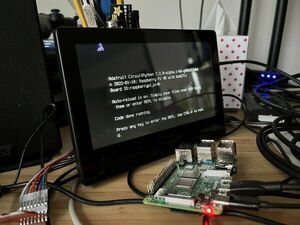
CircuitPython on Raspberry Pi (Bare Metal / No OS)
"The Raspberry Pi single board computers (SBCs for short) are normally used with the Raspberry Pi OS. This is great for gaming and web browsing, but isn't designed for microcontroller-like tasks. Tasks like reading I2C sensors and SPI devices can be trickier. Furthermore, Linux system maintenance can be tricky for beginners. Instead of Raspberry Pi OS, one can now use CircuitPython instead. CircuitPython running without another operating system (OS) is typically known as "bare metal"." [...]
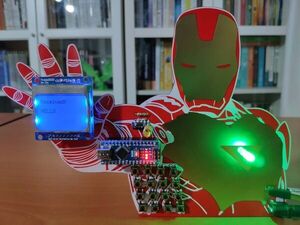
Iron Man Walkie-Talkie (Two-Way Radio) for Texting w/ LoRa
"Via RYLR998 LoRa module and Arduino Nano, create a two-way radio (transceiver) w/ a 4x4 keypad to transmit and receive text messages. For a long time, I have wanted to experiment with LoRa (short for long-range), which is a spread spectrum modulation technique derived from chirp spread spectrum (CSS) technology. Since I am fond of vintage walkie-talkies utilizing radio waves, I decided to create a walkie-talkie (two-way radio) with a LoRa module from scratch to transmit and receive short text messages. After perusing different LoRa module datasheets, I decided to employ the RYLR998 LoRa (transceiver) module since I wanted to make this project as compact as possible. The RYLR998 LoRa module provides ultra-long range spread spectrum communication with high sensitivity and high interference immunity while minimizing current consumption. Also, this module has a built-in antenna and supports AT commands via serial communication." [...]
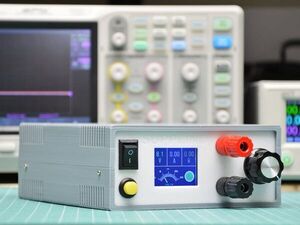
Supplino - DIY PSU
"A simple PSU made with breakout boards and having a cool graphical display Supplino is a Quick & Dirty PSU (Power Supply Unit) made with some widely available breakout boards, an Arduino Nano (or an Arduino Nano Every) and a graphical LCD. Power output is given by a DC/DC buck converter based on the XL4016E1 IC with possibility to regulate the output voltage. Regarding the power input, we prefer feeding it through an external 20÷30V brick PSU such as the ones used for laptops or old printers: this solution is safe and cheap, but you can choose to use a larger enclosure and then include internally your own transformer+diode bridge+capacitors but with a lot of precautions. We used this project to recycle some old printers PSU that have an output voltage of 24V. Arduino does not manage the buck converter module but only measures output voltage and current through a current sensor and then shows those values on a display. Power value is showed too." [...]
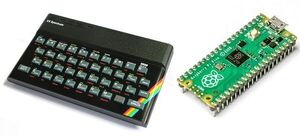
pico-zxspectrum
"48k/128k ZX Spectrum for Raspberry Pico Pi RP2040 This is a basic 48k/128k ZX Spectrum emulation on the RP2040 with DVI output. Uses Wren's Amazing PicoDVI and CarlK's Super no OS FAT FS for Pico libraries. Features - DVI over HDMI output - USB Keyboard input - PWM sound for ear, mic and AY-3-8912 - 12 quick save slots - Load from .z80 snapshot files - Read from .tap tape files - On screen menu system (work in progress)" [...]
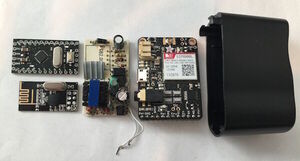
KEYSWEEPER
"KeySweeper is a stealthy Arduino-based device, camouflaged as a functioning USB wall charger, that wirelessly and passively sniffs, decrypts, logs and reports back (over GSM) all keystrokes from any Microsoft wireless keyboard in the vicinity. All keystrokes are logged online and locally. SMS alerts are sent upon trigger words, usernames or URLs, exposing passwords. If unplugged, KeySweeper continues to operate using its internal battery and auto-recharges upon repowering. A web based tool allows live keystroke monitoring. " [...]
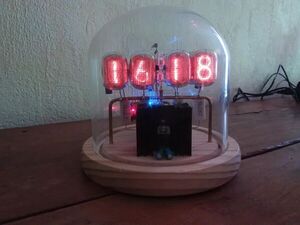
Nixie Clock in a Dome
"This is a Nixie clock 3D wired in a glass dome. It is made with IN-12A (ИН-12A) Nixie tubes and an Arduino nano. This is inspired from a kit I bought a few years ago. I made some modifications to use an Arduino, a DS3231 clock and a DC buck converter module. I also wrote my own program with Arduino IDE. You will need to be very patient to complete this project." [...]

Edison Radio – Best Internet Radio ESP32 – Arduino
"This project is a tribute to Thomas Edison and it's an internet radio Thomas Edison was a great inventor who, amongst other things, improved the microphone for telephones by developing a carbon microphone. In ways, more than one, Edison contributed to worldwide communication. This is an open source project, all schematics, software and building instructions are available for you. Use it, change is, heck even sell it. It’s ok but if you do one or more of the above, please give me credit by linking back to my channel. Talking about Edison, his greatest invention was not this carbon microphone or even his well-known phonograph but, it was the invention of the light bulb by far!" [...]
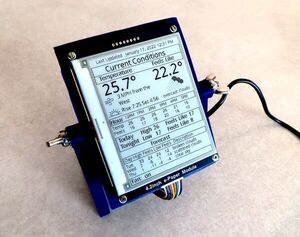
Smart Device Controller Weather Station Using IFTTT
"I created this project to turn an air purifier on and off based on the current weather. Mine depends on temperature, wind speed and direction. Any weather information could be used in your project. IFTTT ( If This Then That) applets are called to turn the smart plug on and off. Other smart items could be controlled with easy Python program changes and additions. The 4.2 inch weather display is an added bonus!" [...]
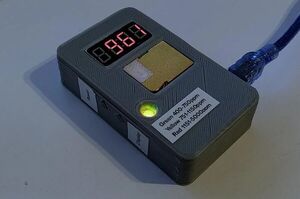
CO2 Level Indicator (4x7 Segment RGB LED Manual Calibration)
"This DIY project shows you how to make your own CO2 level indicator, which shows you CO2 concentration (PPM - parts per million) when button is pressed and always on RGB LED shows constantly how good or bad your surrounding air quality is. The project was done due to COVID-19 which spreads easily when air quality is poor. CO2 sensors with displays are nowadays quite expensive (starting from 120 and above) and if you want to monitor multiple room air quality at the same time then it is reasonable to do few sensors with displays on your own. Making just one costs about 40-60 depending from where you are getting your parts. Supplies: 1 x Soldering iron 1 x Cutting pliers 1 x Tweezers 1 x Multimeter (optional) 1 x Tin 20-100 cm depending on thickness 1 x CO2 sensor MH-Z19 or MH-Z19C 1 x 7-segment display TM1637 1 x Arduino nano 1 x 5 mm RGB LED 5 mm (common cathode) 3 x 220 ohm resistors (SMD 0603) 1 x PCB 1 x 3D printed case" [...]
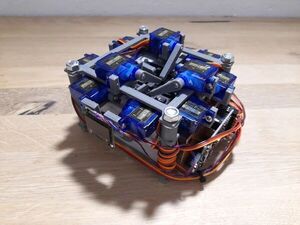
Keypad Password Decoding Machine
"Arduino machine that figure out keypad password. Supplies - 11 pcs 9g servo motor - Arduino mega mini - Arduino nano - Keypad - Oled display - Led - Photoresistor - Pcb - Pin headers - 6mm rod and m6 nuts - 3d printed parts" [...]

Miniature CO2 Monitor With Alarm
"I have recently been spending a lot of time indoors working with human breathing physiology. Prior Instructables have used O2 and CO2 sensors and I had tried switching to a new one from Sensirion SCD 41. It is very tiny and uses a new type of sensing for the level of CO2 ...acoustic something or other. The previous version: SCD 30 works really fast and has a wide detection range...it is based on laser CO2 light absorption. When experimenting with the small model I found its speed too slow for my use and the range limiting so I was looking for something else to build with them. I have put together a short instructable on how to built a elegant very tiny CO2 sampler for home or school use." [...]

Perpetual Calendar With Google Calendar Connection
"This project is an improved version of the calendar that I made more than a year ago, it still works very well and has become a common object in my living room. I'm a little more conservative, I don't always have the phone in my hand and I like that I can see a monthly calendar in front of me and notice at a glance what date is today (often I forget) or next week on what date the weekend starts and very important, when the payday will be :) There are two major differences of this construction compared to the previous project: The body of the calendar is 3D printed, except for the piece of smoked acrylic that can be cut by hand; The calendar can be synchronized with one or more calendars defined in Google Calendar. There are also other small differences that I will present in the following steps. Supplies: - 3D printed components - A piece of 2 mm thick 191mmx69 smoked acrylic - 75 WS2812 LEDs in a strip with 60 leds/m; - An ESP-01 module, - A 5V/3.3V stabilizer module; - A DC female plug with 5.5mm/2.5mm cable; - 5V/2A power supply with 5.5mm/2.5mm DC male plug; - White colored paper; - Wires of different colors, hot glue. " [...]
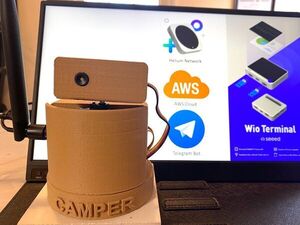
AI thermal camera for safe camping (Seeed+Helium+AWS) (V2)
"TinyML model running Wio Terminal can identify if animal or human is approaching even in the dark, sends data to Helium LoRa network to AWS. In the previous project, I used Wifi connection to send tinyML inference data to AWS IoT. As you can imagine, this device is meant for camping, away from your home wifi network, LoRa makes more sense instead of wifi connectivity. In this project, I am using Helium network which is the most popular choice these days due to broader network coverage and it's growing rapidly. I am going to use same Edge Impulse model. If you are interested in tinyML part, please checkout my previous project." [...]
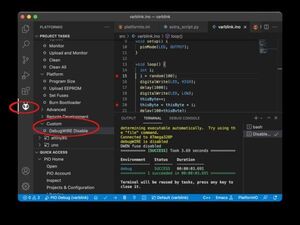
Debugging an Arduino project with GDB on Classic ATtiny and Small ATmega MCUs
"A tutorial for people who finally want to debug their Arduino projects that run on AVR MCUs using the GNU project debugger GDB The current Arduino IDE does unfortunately not support debugging. Even the new beta version supports debugging only for ARM MCUs. With a few easy steps, it is nevertheless possible to use avr-gdb in order to debug your Arduino project on many AVR chips. In this article, I will focus on MCUs that support debugWIRE, i.e., the classic ATtinys and the ATmegaX8 family. Introduction The Arduino IDE is very simple and makes it easy to get started. After a while, however, one notes that a lot of important features are missing." [...]
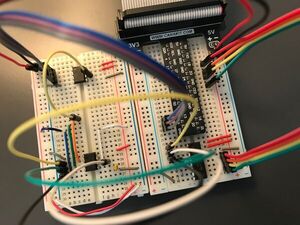
Understanding the 555 Timer IC
"I had a really difficult time understanding exactly what 555 timer circuits do and how they work. Most explanations online refer to their functionality when paired with RC series, but not exactly what logical interactions between the different input pins are. To wrap my head around what was going on, I conducted some experiments much like those I did to understand how BJT transistors work. I used a Raspberry Pi to control the experiments and log the results a TLC555 chip, which came as a part of my Adafruit Parts Pal an MCP41010 digital potentiometer to vary the input voltages on different 555 pins an MCP3008 analog-to-digital converter to read the 555's output voltage pin Given that the 555 timer has four input pins (TRIG, RESET, THRES, and CONT) and one relevant output pin (OUT), the idea is to hold three of the input pins fixed, then vary the fourth with the MCP41010 and measure the effect on the OUT pin with the MCP3008. " [...]
Secção Videos
Videos interessantes.
That's all Folks!



